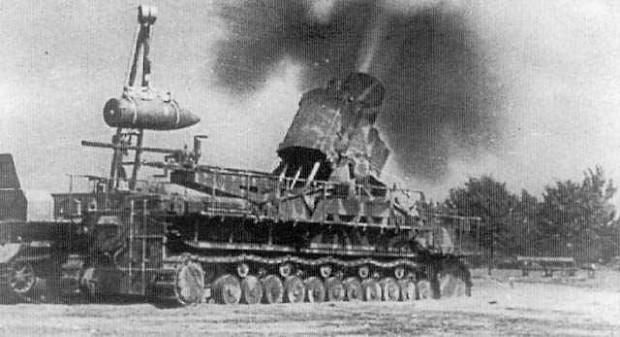Artillery Lovers Group
Hobbies & Interests
Originally applied to any group of infantry primarily armed with projectile weapons, artillery has over time become limited in meaning to refer only to those engines of war that operate by projection of munitions far beyond the range of effect of personal weapons. These engines comprise specialised devices which use some form of stored energy to operate, whether mechanical, chemical, or electromagnetic. Originally designed to breach fortifications, they have evolved from nearly static installations intended to reduce a single obstacle to highly mobile weapons of great flexibility in which now reposes the greater portion of a modern army's offensive capabilities.
"Karl-Gerät" (040/041) (German literally "Karl-device"), also known as Thor and Mörser Karl, was a World War II German self-propelled siege mortar (Mörser) designed and built by Rheinmetall. It was the largest self-propelled weapon to see service. Its heaviest munition was a 60 cm (24 in) diameter, 2,170 kg (4,800 lb) shell, and the range for its lightest shell of 1,250 kg (2,800 lb) was just over 10 km (6.2 mi). Each gun had to be accompanied by a crane, a heavy transport trailer, and several modified tanks to carry shells.
Seven guns were built, of which six saw combat between 1941 and 1945. It was used in attacking the Soviet fortresses of Brest-Litovsk and Sevastopol, bombarded Polish resistance fighters in Warsaw and participated in the Battle of the Bulge and the attacks against the Remagen Bridgehead. Only two exist today; the others were scrapped after the war.
Type Self-propelled siege mortar
Place of origin Nazi Germany
Service history
In service 1941–1945
Used by Nazi Germany
Wars World War II
Production history
Designer Rheinmetall
Designed 1937–1940
Manufacturer Rheinmetall
Produced 1940–1942
Number built 7
Variants Gerät 041
Specifications
Weight 124 t (137 short tons; 122 long tons) (firing)
Length 11.15 m (36 ft 7 in)
Barrel length 4.2 m (13 ft 9 in) L/7
Width 3.16 m (10 ft 4 in)
Height 4.38 m (14 ft 4 in) (firing)
Crew 21 (Gun Commander, Driver, Assistant Driver, 18 x Gunners)
Shell separate loading, cased charges
Caliber 60 cm (24 in)
Breech horizontal sliding wedge
Recoil hydro-pneumatic
Elevation 55° to 70°
Traverse 8°
Rate of fire 1 round/10 min
Engine Daimler-Benz MB 503 A gasoline or Daimler-Benz MB 507 C diesel
580 hp (590 PS)
Power/weight 4.8 hp/ton
Suspension torsion-bar
Fuel capacity 1,200 l (260 imp gal; 320 US gal)
Operational
range 42 km (26 mi) (gasoline engine)
60 kilometres (37 mi) (diesel engine)
Speed 6 to 10 km/h (3.7 to 6.2 mph)







That would have been scary to be there when it fired wonder if it coursed defness, but all that aside it is a pretty awsome mortor